Well here we are, starting another weekend. I got off to a great start, but then other things came along and got in the way. I have also had a cold, for the first time in ages. And it has been cold and rainy, and dark at night. However, I seem to managed to pull something together, despite those.
I am told there are only fifteen more weekends until Christmas. So I suppose it is time to start making a list and checking it, twice. Cards make a very acceptable present, and if you know someone who is fond of a certain subject, but does not collect cards, why not introduce them, with a small and inexpensive set.
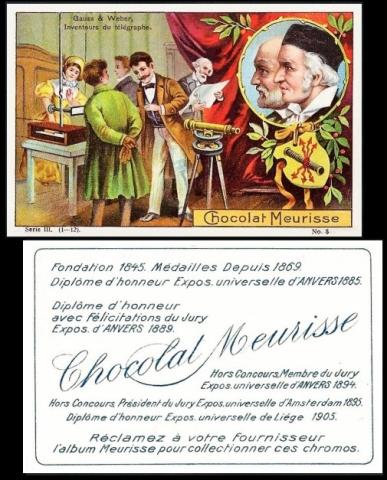
Chocolat MEURISSE [trade : chocolate : O/S - Belgium] "Inventeurs" (1905) 5/12
Let us begin with a centenary, and quite a surprising one, as it was only in 1925 that Western Union announced that they had managed to send a message between London and San Francisco, using a new system which automatically repeated the message all the way along the line, and did away with the operators, who had to accept the message, copy it out, and then start it on its way again.
As for the first electric telegraph, this had come along in 1816, courtesy of Francis Ronalds. The next stage was reached, almost at the same time, by two British men, Messrs. Cooke and Wheatstone and the American Samuel Morse. The main difference was that the former was much more complex, and that is almost certainly why the Morse system was preferred.
Our men, Johann Friedrich Carl Gauss, and Wilhelm Weber, did actually invent one of the earliest telegraphs. Herr. Gauss was the director of Gottingen Observatory, and Herr. Weber who worked in the Physics Department, a mile away. Their system was a simple one, just a wire, from one building to the other, and it did actually work, but the observatory was not interested in supporting them with applying for a patent, and so the idea was abandoned.
Gauss is a very interesting man, who actually proved that the heptadecagon, a shape with seventeen sides, could be drawn, and moulded. He was so proud of this fact that he asked that one be carved into his headstone, but no stone-mason was able to form the shape.He also invented the heliotrope (a signalling device that used a mirror), the magnometer (which we call the magnetometer), and the electrodynamometer. And his name was also immortalised, as a unit of magnetic flux density - as was the Weber, named after Wilhelm Weber.
Our card is from "Inventeurs", and that comprises the following cards :
- Johannes Gütenberg - Inventeur de la typographie
- Aloys Senefelder - Inventeur de la lithographie
- Jacobi - Inventeur de la galvanoplastie [electroplating]
- L.I.M. Daguerre - Inventeur de la photographie
- Gauss & Weber - Inventeurs du telegraphe
- Phillippe Reis - Inventeur du telephone
- Berthold Schwarz - Inventeur de la poudre a canon [gunpowder]
- Otto v. Guericke..Iventeur de la machine electrique.
- Denis Papin - Inventeur du bateau à vapeur [steamboat]
- Johann Friedrich Bottger - Inventeur de la porcelaine
- Lebon, La première usine à gaz (Londres) [gas lighting, London]
- Alfred Nobel - Inventeur de la dynamite
And many thanks to a new correspondent for supplying the inventor`s identity on card number eight ...
By the way, you will often find cards from this set advertised as "Inventeurs, series III". But I am coming to think that it was instead the third series in this particular format that Meurisse issued, rather than a third series of inventors, especially as I found no cards from an Inventors series one or two.
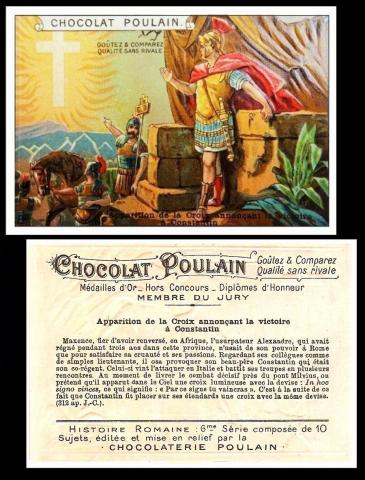
Chocolat POULAIN [trade : chocolate : O/S - France] "Histoire Romaine" / "Roman History"- sixth series
So today I loved the subject, but could not find a card, however I was reluctant to give it up, so I persevered and here we are.
What happened was that today, in 1925, so another centenary, a Byzantine cross appeared in the skies over Athens. For the third time.
Strangely, and maybe even connectedly, it was the evening before the feast of the Exaltation of the All-Honourable and Life-giving Cross of our Saviour, an event which usually sees an all night vigil. And on this night, about half an hour before midnight, a light started to shine in the sky, slowly turning into a cross, which pointed directly at the church of St. John the Theologian. The cross was there for half an hour, right until midnight, then eyewitnesses report that it slowly rose in the sky until it was laying almost flat, and then started to fade. And there were plenty of eyewitnesses, some twenty thousand eventually having gathered in the streets and in the churchyard.
Strangest of all is that I believed I had taken a bit of a liberty with our card because this is not a Byzantine cross, that having another bar, diagonally across the vertical, towards the bottom. But on researching I find that the cross on our card is connected, it is the second appearance, to Emperor Constantine in Jerusalem, on May 7th, 351, the light of which spread from Golgotha to the Mount of Olives.
As for the first appearance, that was was in 312, and it was during the reign of Constantine`s father. That was slightly different too, as it had words on it, "By This Conquer". I believe that they would have been in Latin though. It appeared in the sky at noon, and was made up of little individual stars with the words clearly carved between them.
This set has ten cards, but there are actually six sets, tracing right through Roman history. You can see a card from the first, or "1-eme" set in our newsletter of the 19th of April, 1925, but you will need to scroll down to Monday, 21st April. There is also a list of all the cards in that sub-section, save card seven which is still elusive.
Our set was also issued by Emile Bonzel, of Haubordin (Nord), and by Casiez Bourgeois, of Cambrai, both with chicory coffee, but in both those versions the cards are numbered consecutively from one to sixty, whereas our sets are six groups of ten and each numbered one to ten.
The cards in this set, again with two eluding me, are :
- Decebale roi des Daces s`asservit a l`empereur Trajan
- Mort de l'Empereur Trajan
- Caracalla assassine son frère dans les bras de sa mere
- Ardeschir Babekan contre l`empereur Alexandre Severe
- L'empereur Valérien prisonnier de Sapor roi des Perses
- La reine de Palmyra est faite prisonniere
- Apparition de la croix annonçant victoire à Constantin
- Pillage de Rome par les vandales
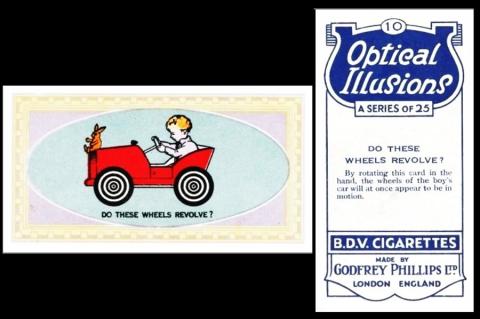
Godfrey PHILLIPS [tobacco : UK - London] "Optical Illusions" (1927) 10/25
Today is National Custom Framing Day, which perhaps may have suggested a discussion of why sets with a mixture of horizontal and vertical cards are so difficult to frame - or even why the framing of cards, once all the rage, seems to be a trade that is no longer plied.
Instead of that, I found this, a card that is definitely custom framed, and several times, firstly by the thin white border surrounding the green oval, then by another white border which holds the mauve square. And if that were not enough, the main yellow frame is actually three, a solid yellow, a dashed one in brown, and another solid yellow. And all that is frames by the white of the margin.
This is an interesting set, and along with the line and circle puzzles, you will find a toucan, three crows, a rabbit, a character who is named on the reverse as "The Scotchman", plus our little pedal car, with its fluffy bunny mascot.
The pedal car was made of wood and metal, and named after its mode of propulsion, for the child sat on the seat and pedalled, with their feet, sending it forward. It seems that the first pedal cars appeared not long after the first cars, and they were pretty much exclusively for the rich. However, not too long after that, people started making their own, which may not have been so elaborate, but were probably more fun. Some of these were not true pedal cars, as they were propelled, far more simply, by the child walking it along with their feet on the floor.
It looks like the wooden ones continued until about 1910, when the latest development saw the car body made of metal, usually sheet steel. This made them cheaper, and lighter, enough to appear in mail order catalogues. And with a break in production, during the First and Second World War, they were one of the favourite toys, for boys and girls.
In the late 1960s, all this changed, due to plastic. Plastic was lighter, and more colourful, and there was also a movement away from cars, with all manner of vehicles, even spaceships. This was also fuelled by the fact that the old style of pedal car was based on pre-war cars, and the children, whose voices were beginning to be heard, wanted something new.
Strangely the wheel has gone full circle. Early pedal cars are collected by adults, and children, with richer parents, have cars that are actually driven by motors or electricity, with no need at all for them to pedal.
And if anyone knows of any other cards showing these little vehicles, do please tell us.
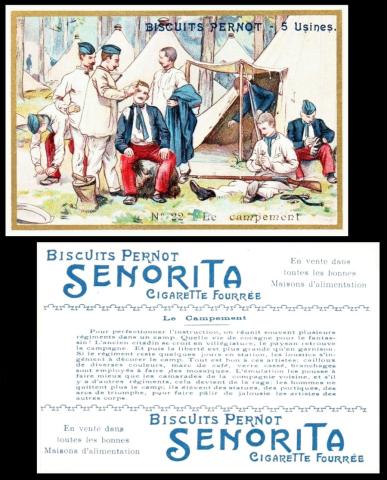
Biscuits PERNOT [trade : biscuits : O/S - Dijon, France] "La vie du Soldat" (1914) 22/??
Today is World Barber Day. It was nearly Collect Rocks Day, but I found a barber first.
The true definition of a barber is someone who works with hair, though it has come to include facial hair as well as that on the head. Throughout history they have also taken on other roles, dentistry and surgery being two of the most common. They have also long been regarded as meeting places, especially for men, hence the connection to the barber-shop quartet. We know that this began in Ancient Greece, and was adopted by the Romans. In fact they went every day, maybe not always to have work done, but always to catch up with local gossip and news.
I suppose that without the "barber" title, someone who was good at cutting other people`s hair would have been known in prehistory, for hair grows, and obscures the vision. I had to research this, but it appears the razor was a development of flints or oyster shells, ground to a sharp edge.
This card is a link to one in the last newsletter, because though this is by Biscuits Pernot, that one, featured on Thursday the 11th September, was by Ch. Jux - which, though I have not yet added this there, I now know to be a shortening of "Chocolate". And yes, it appears to be exactly the same set, right down to the elaborate typeface used for the title on the front. However ours has the bonus of also having text on the reverse, though it is slightly illegible here, it is quite light.
I am still not sure of the title of the set though...
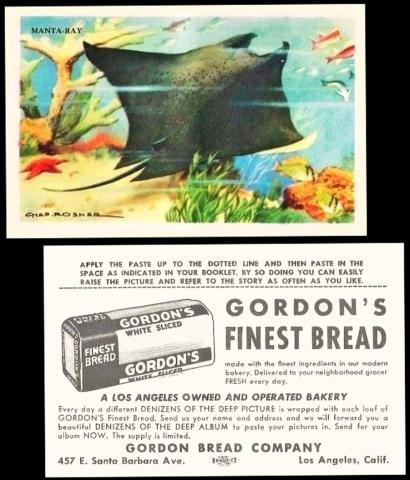
Gordon Bread Company [trade : bread : O/S - Los Angeles, California, USA] "Denizens of the Deep" (1949) Un/24 - D39-13
Today is National Manta Day, another day I fought for. But again cards of mantas are not that prevalent. This is a donation, from a reader, and its a really great one, but it took a fair bit of research to find out about the company. And there are still lots of gaps.
We know that by the start of the Second World War the Gordon Bread Company was already well established in Los Angeles. It is thought that they started by providing cheap bread to those affected by the Great Depression. However after that they moved into more specialty bread, and that is what made their name.
They ought to be better known though, because they had a gimmick, and that was the inclusion of cards and other items inside the packaging. On this card it actually says that "Every day a different DENIZENS OF THE DEEP PICTURE is wrapped with each loaf of GORDON`S FINEST BREAD". And they were so well known for this that they were able to pick up the rights to use Flash Gordon on their cards.
The problem is that the cards were issued before pre-gumming came along, so you had to use your own adhesive to stick them in the album, and this was not always done with care - indeed it is quite hard to find them without some kind of a pull mark where the two were forced to part company before they were really ready to do so.
Our card was drawn by Chas. Rosner. We know he drew other cards too, for other companies, but I cannot find much about the man.
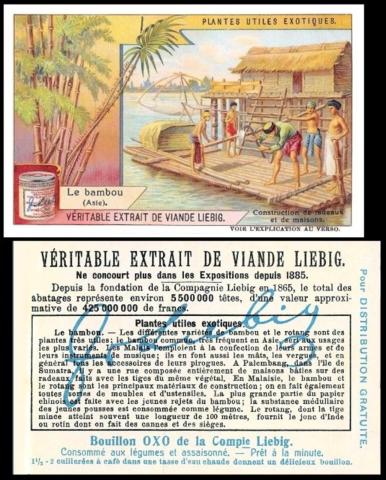
LIEBIG [trade : meat extract : O/S - South America] "Plantes Utiles Exotiques" (1909) F.0967 : S.0970
Time now to reflect on World Bamboo Day, which is today.
Bamboo has a rough press, but it is not just a nuisance in the garden, only fit to be hacked down; in the right place it is a source of building material, as shown here, and as food for pandas and other species.
Sadly it is their nature to be invasive, and this is compounded by the fact that they are also the fastest growing plant in the world, capable of growing three feet in length per day - and, in the case of one Japanese species, of growing almost four feet in the same period.
They originated, as our card says, in Asia, though there is much debate as to whether it began in China or in Japan. However it was the Indian form which was first introduced to the English garden, as a hothouse delight, its speed of growth being a wonder.
This set includes :
- La gynerion argente (Amerique de Sud)
- Le bambou (Asie)
- Le mais (Amerique)
- Le manioc (Amerique centrale)
- Le ravenala (Madagascar)
- Le safran (Asie mineure)
I have not been able to find the reference numbers for this set, but maybe you can help.
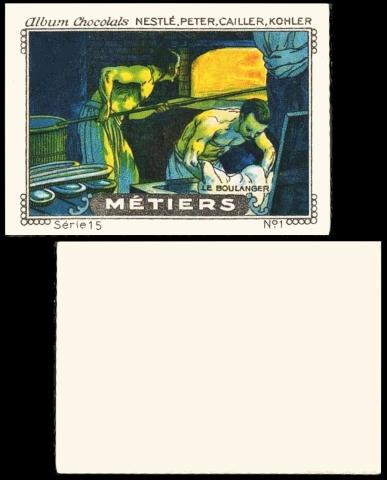
Nestle, Peter, Cailler, Kohler [trade : chocolate : O/S - Switzerland] "Metiers" / professions (1930s) 1/12
Today is National Tradesman`s Day, and I have to say that this is a very odd card, from the darkness of it you would imagine these men to be miners, or blast furnace workers, but no, they are bakers. And I do not think I have ever seen a card that makes that occupation quite so gloomy.
This is another of those fun little Nestle paper thin, almost stamp, cards, on careers - and making up the set are :
- Le Boulanger (baker)
- Le Cordonnier (leather worker)
- Le Tailleur (tailor)
- Le Macon (mason)
- Le Charpentier (Carpenter)
- Le Menuisier
- Le Peintre (painter)
- Le Potier (potter)
- L`Horloger (clockmaker)
- Le Mecanicien (car mechanic)
- Le Marechal Ferrant (blacksmith)
- Le Mineur (coal miner)
As usual this set was issued several times, so you can find this picture as part of
- Nestle - Serie X (title at top, issuer in brown cartouche at bottom inside picture)
- Nestle, Peter, Cailler, Kohler - Serie 15 (issuer`s names at top, title in brown cartouche at bottom inside picture)
- Nestle, Peter, Cailler, Kohler - Serie 15 B (issuer`s names at top, title in brown cartouche at bottom inside picture)
- Peter, Cailler, Kohler, Nestle - Serie XV (issuer`s names at top, title in brown cartouche at bottom inside picture
This week's Cards of the Day...
this week we are joining Royal Mail, whose new commemorative stamps celebrate what they call "our Wetlands Webbed Wonders", but we know, more familiarly, as ducks. These are released on the 11th of September, and feature photographic representations of just a few of the types of duck that you can find, namely :
- Aylesbury (first class)
- Call (second class)
- Eider (first class)
- Goosander (second class)
- Indian Runner (second class)
- Mallard duckling (second class)
- Mandarin (second class)
- Pintail (first class)
- Shelduck (first class)
- Silver Appleyard (first class)
They are also available as postcards, and with a first day cover which can be postmarked at Ducklington near Witney, or at Tallents House, in Edinburgh, which is the official Philatelic and Postal History centre.
Now if we nip back in the archives, you will find that we have featured ducks before -
- as our Card of the Day for the 23rd of September, 2024 (the Rouen Duck, the Mallard, and the Indian Runner - as an allusion to Sit Francis Drake). This was a Peter, Cailler, Kohler, & Nestlé plain backed stamp-style paper card, from serie XV, "Oiseaux de Basse Cour" (1930s).
. - as our Card of the Day for the 8th of January 2024 (the Aylesbury Drake - as an allusion to the Metropolitan Line, which, a while ago, actually used to be its Western Terminus. Nowadays it is Amersham or Chesham). This was from Ogdens "Fowls, Pigeons and Dogs" (May 1904)
Saturday, 6th September 2025
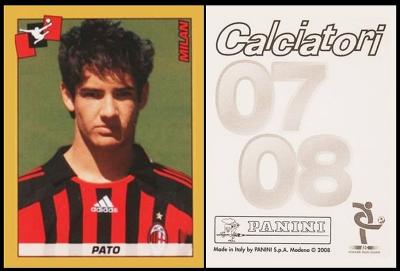
This is a strange fact, but this man`s name is Alexandre Rodrigues da Silva. He took his name from his birthplace, Pato Branco in Brazil, and also from the fact that that at one time before the invention of the football, people would kick a bag with a duck in it - so as Pato means duck in Spanish and Portuguese, it came to also mean the so called sport.
He was born in Brazil on the second of September 1989, and his talent was spotted early - at the age of eleven he was playing for Sport Club Internacional, based at Porto Alegre. He stayed with them and joined the main team in 2006, but only for one year, before he was picked up by A.C. Milan and moved to Italy. He was there until 2013, then suddenly he was back in Brazil, playing for Sport Club Corinthians Paulista. They also loaned him, twice, to Sao Paulo Futebol Club, in 2014, and back to England, for less than a year, to play for Chelsea.
This was the catalyst which saw him embark on pretty much a World Tour, starting in Spain, with Villareal Club de Futbol of Valencia, then off to Tianjin Tianhai F.C., in China. He left there in 2019, and returned to Sao Paulo, from where, in just over a year, he found himself in America, playing for Orlando City, Florida. After that, in 2023, he returned to Sao Paulo again and then retired, not so long after. at the age of just thirty-four..
Since then, he has remained within the sport, but as a sports commentator.
This card is universally regarded to be his "Rookie" card, and that is supported a great deal by the word "Aggiornamenti", which means update - in other words, footballers added to the teams since the main set was issued. The cards added in for this team, A.C. Milan, are Guiseppi Favalli, Valerio Fiori, Pato, Alberto Paloschi, Serginho, and Dario Simic. Most of these simply moved there from another team, but this set also provides us with the "Rookie" card of Alberto Paloschi
The main set is known as Calciatori 07 08, or 2007/2008. That is a set of seven hundred and five stickers, twenty-four of which show A.C. Milan. However, there seems absolutely no difference between our card and the main set, they have the same yellowy orange border, the same logos, etc. The only difference seems to be that our card and those from the update set are not actually numbered. So technically, although a lot of football websites call this card A.66, that is not the truth according to the card.
Sunday, 7th September 2025
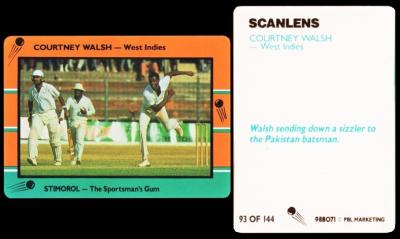
Courtney Andrew Walsh, showing here, is currently the man with the record of having the most "ducks" in Test Cricket - some forty-three, out of a hundred and eighty-five innings. If you are not a cricketer, let me explain this - what happens is that if a batsman gets struck out after coming to the field, but before making any runs at all, he is said to be "out for a duck".
He was born on October the 30th, 1962, in Kingston, Jamaica, and represented his country from 1984, against Australia in Perth, until 2001, against South Africa, at home in Jamaica. In between were some twenty-two test matches as the Captain of the side.
After his retirement he was still involved with cricket, and was a selector for the West Indies team, as well as the bowling coach of the Bangladesh team.
This set, which is, thrillingly, still trade - the packets containing cards and one stick of bubble gum - is only catalogued in volume two of our Australian and New Zealand Index, where the entry reads :
- 1988-3. Cricket Series. 88 x 63. Nd. (144). 141 players and scenes and three advertisement subjects. ... SC2-90
By the way, he actually appears twice in the set, the other card being number 78, which shows his head and shoulders rather than in action, and has a biography on the reverse.
There is a school of thought that suggests the cards ought to be called "Cricket Cards 1988-89 Season" - for this is the title which appears on the packets. There is also no mention in our index of something else that appears there, the fact that there was a competition, which closed on the 25th of November 1988, involving some of the cards, namely 8 (Allan Border) - 14 (David Boon) - 64 (a Bicentennial Test Match, named as Allan Border), 102 (Desmond Haynes), 117 (Javed Miandad) and 124 (Imran Khan).
Now the catalogues state that this is a set of 144 but there are several cards, 31, 42, 51, 57, 99, and 123, which are blue and white cards, all text and no pictures, which give the rules, And cards 130, 143 and 144 are not cricket either - they are adverts for The Hilton International Hotel in Sydney, World series Cricket, and Ansett Airlines. I am not so sure that these are deserving of the numbers, but never mind. They explain that you have to identify the players on those cards and send the list of names back to Scanlens, then on December the 9th, 1988. a draw would be made of all the correct entries and the winner would be awarded a trip to two to the the First World series Cup Final at the Melbourne Cricket Ground.
Monday, 8th September 2025
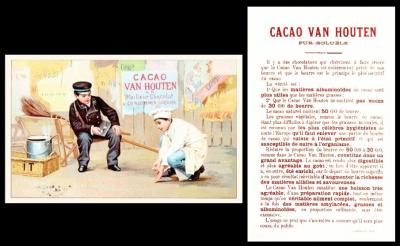
This is a really strange connection, so well done if you got it. It refers to the fact that in the game of marbles, you lay a ring out on the floor with a piece of string, then scatter a group of marbles inside it. Once the string is removed it ought to have made a mark on the dusted surface, and the idea is that you flick your "shooter" marble at the group, hoping to knock the ones inside the ring outside it. Now the marbles on that floor, that you shoot, at are called "ducks" - and this appears to also be the true origin of the phrase "a sitting duck".
This is a lovely card, showing a youthful chef whiling away his spare time by playing marbles with a chauffeur of a similar age.
And I was coming to the conclusion that it is the only card to ever show the game of marbles, but I have been told that this is wrong - the game is featured on card 15 of Sarony`s "Origin of Games", which tells us that "The origin of this game is concealed in the mists of antiquity, Marbles were used by Egyptian and Roman children before the Christian era, and can be seen in the British Museum, Probably the small stone spheres found among neolithic remains are prehistoric marbles. No doubt the game that the youthful Augustus, like all Roman children, played with nuts was a form of marbles. The earliest unmistakable reference to marbles was in the 12th century."
This is interesting, as most sites agree that marbles date back to prehistory, when they were made of clay, stolen from the banks of rivers, then rolled round in the palms and made to a rounder shape, before being laid out in the sun to harden. But of course, just like the card says, rolling an object, a nut, a stone, would definitely have come first.
Since I started this, I have also been told of a dedicated website, buymarbles.com, which has a section showing lots of other chromos and trade cards - including ours! It does not list the set names though, so I am still guessing that.
There are also two modern trade/commercial sets, each of eight medium sized cards, measuring 73 x 52 m/m, showcasing the marbles themselves, both by Design At London Colour Ltd. These are called "Marbles The Beauty of Glass & Stone", and there is a first and second series, both of which were issued in 2024.
Strangely, there seems to be no standardised rules, but there are lots of regional variations, and many different ways to play. The main ones, though, seem to either to strike an assigned marble with yours, or come closest thereto (a bit like bowling), or to knock as many out of a ring as you can, the one who knocks the most in one strike, or a combination of strikes being the winner.
There is also a superstition, that it can only be played from Ash Wednesday, until mid-day on Good Friday. After that to play was bad luck. We are not sure why this is.
Tuesday, 9th September 2025
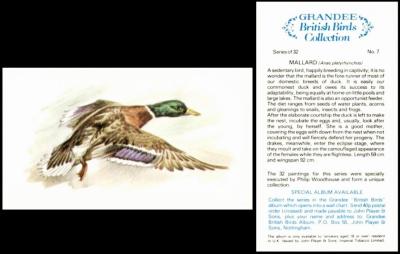
We started with this duck, the Mallard, because whilst it is only amongst the oldest species known, it is the ancestor of most other domestic breeds, only the Muscovy having no trace at all of the Mallard. They were also the first breed to be domesticated, in China, about four thousand years ago. And they are one of the most familiar of all breeds, with their bright green necks.
Mallards usually live for five to ten years, but there was one who lived to be twenty-seven. It is therefore likely that they could live longer if circumstances allow, a lack of predators, good food, a safe place to spend the night.
This is a fairly recent set, issued long after our original World Tobacco Issues Index, so only recorded in our updated version, as :
- GRANDEE BRITISH BIRDS COLLECTION. Md. 89 x 52. Nd. (32). Album/wall chart issued. An edition exists numbered on the front and with a slightly different back format, it may be a proof ... P644-416
So is there anyone reading who can supply more details of that other version? Maybe even a scan....
We know that the album/wallchart cost 40p, to be sent as a crossed postal order - and that it is a "front cover" that folds out not into pages but into four sections of the same size.
The artwork was by Philip Woodhouse, but I cannot track him down either, yet!
Wednesday, 10th September 2025
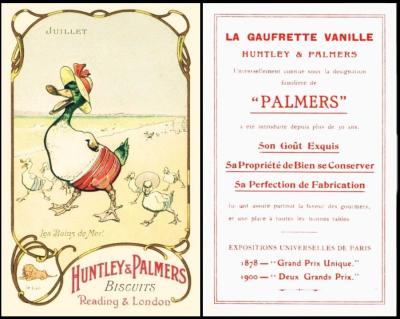
This is not an actual duck but it is a really lovely image, and it is one of a series, of twelve cards showing the months of the year with different animal images And the image in the small oval beside the Huntley & Palmers name is also important as it is the zodiac sign for that month -
- Janvier - Les Etrennes - Le Verseau (January - New Year`s Day - The water bearer/Aquarius) : a monkey with shopping, advert "Sponge Rusks" or "La Gaufrette Vanille"
- Fevrier
- Mars - Le Premier Soleil - Le Belier (March - The first sunshine - The ram/Aries) - a pair of cats in London, advert "Sponge Rusks"
- Avril - Les ouefs de Paques - Le Taureau (April - Easter Eggs - Taurus) - a chicken with a basket, advert "La Gaufrette Vanille"
- Mai - Le Retour des Hirondelles - Les Jumeaux (May - the Swallows return - Gemini) swallows flying in with suitcases, advert "La Gaufrette Vanille"
- Juin - La Peche - L`ecrevisse (June - Fishing - crayfish?/) - a frog with a creel and rod, advert "La Gaufrette Vanille"
- Juillet - Les Bains de Mer - La Lion (July - the seaside - Leo) - a duck and ducklings in bathing costume, advert "La Gaufrette Vanille"
- Aout - Les Chaleurs - La Vierge (August - the heat - Virgo) - a band of musical bugs, advert "La Gaufrette Vanille"
- Septembre
- Octobre - Les Vendanges - Le Scorpion (October - the grape harvest - Scorpio) - a fox with a basket of grapes, advert "Sponge Rusks" or "La Gaufrette Vanille"
- Novembre - Preparatifs d`Hiver - Le Sagitaire (November - preparing for winter - Sagittarius) - a bear with a chicken and rat on a pole? Maybe its not a bear?, advert "La Gaufrette Vanille"
- Decembre - L`Hiver - Le Capricorne (December - Winter - Capricorn) - white bears gathering wood, advert "Sponge Rusks" or "La Gaufrette Vanille"
I still need some of these, but lost more than nine minutes last night watching the X Files, twenty three years to the day after it was first shown on American tv. Still as good as ever. What can I say.
Thursday, 11th September 2025
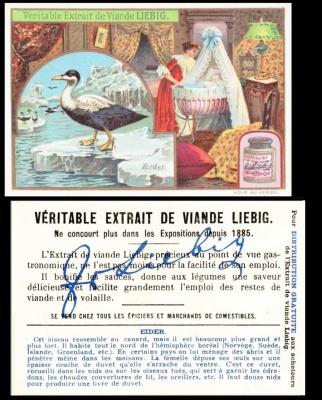
The Eider is very heavy, perhaps because its feathers are so tightly packed - but oddly it is also the fastest duck in flight of them all. You will mainly find them on the coasts, where shellfish, its favourite food, is more prevalent.
We know them most for the fact that their feathers are used in proper eider-downs. Most of these feathers are collected, quite kindly, from the nests after the breeding season is over. This is possibly how it came to be discovered that they were warm and comfortable, and so the idea began to sew them in a cover and use them on a human bed. As far as when the collecting began, we are not sure, but we do know that the Vikings used them for warmth on their sea journeys.
Each card has the bird in a frame and then a scene of how it is used as the main image. The cards are unnumbered, but show the following :
- Carrier Pigeons (flying from a ship to deliver a message)
- Chickens and Turkeys (for Christmas meat)
- Eider (for feathers for bedding)
- Hummingbird and Ostrich (for feathers for hats)
- Pheasants (for food)
- Seagulls (for guano)
This set was issued in France and Belgium under the same title as here, "Oiseaux Utiles" - in Germany as "Nutzgeflugel" - in the Netherlands as "Nuttige Vogels", and in Italy as "Uccelli Utili". As far as values the Belgian version is much more easily available, and therefore the cheapest, at around £5-10 a set, whilst the most expensive is usually said to be the one from the Netherlands, at about £50. The set was also issued in Spain, but this version is extraordinarily rare, so rare that I have not even been able to find out the title.
Friday, 12th September 2025
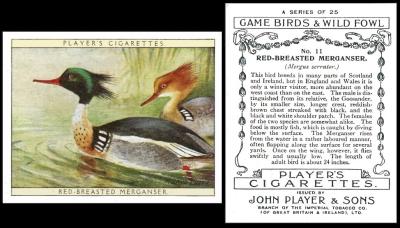
Closing our week, we have this lovely pair of Mergansers, also known as Goosanders, though, oddly, Merganser is more commonly used in America - in Europe and Asia we tend to prefer to call it a Goosander. It mainly eats fish, and lives on rivers and lakes, especially in forested areas, where it can make its nests in the trees.
We know that the bird was known to the Romans, and that they called it Mergus, a name which was borrowed in the 18th century by Carl Linnaeus, who gave it the name of Mergus Merganser. The "anser" part actually means goose, which is almost certainly where the Goosander comes from, but there is no connection genetically with the goose family. It seems likely, therefore, that it simply refers to the fact that it is a large duck, and similar to a goose in size.
And it is very likely that this pair was drawn, from life, in Norfolk.
This set has two sizes, which are catalogued in our original John Player booklet, RB.17, published in 1950, as :
- 105. GAME BIRDS AND WILD FOWL. Subjects designed by Roland Green, F.Z.S. Fronts in colour. Backs in grey with descriptive text. Home issues.
A. 50 Small cards. Issued June 1927
B. 25 Large cards, Issued November 1928.
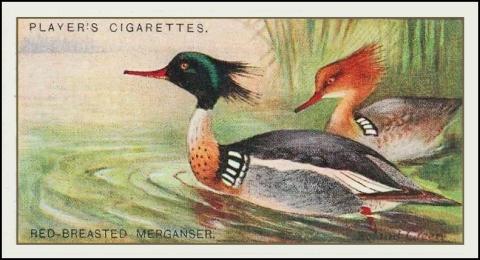
The small size are much more readily available. Curiously the smaller cards actually fit more of the picture in, this one having been trimmed to the sides, removing half the brown duck and some of the rippling water. Because of this, the "PLAYER`S CIGARETTES" and "RED BREASTED MERGANSER", which appears in the picture of the small card, on the left hand side, where the excision took place, has been removed on the large one, instead being placed in two light coloured borders, the "Player`s" at the top and the duck`s name at the bottom.
Roland Green, Fellow of the Zoological Society,.was born in Rainham, in Kent, on the 9th of January, 1890. His father was a taxidermist, who taught his son all about the anatomy of birds. However, he did not want to follow that trade, he wanted, instead, to be a painter, and more than that, to paint directly from life rather than from photographs, or from taxidermy, which was the norm at that time, neither of which he felt gave a true representation of the birds. Later on he moved to Hickling, in Norfolk, to a houseboat, which allowed him to observe birds all about him. He also came across a disused mill, Hickling Broad Mill - which is now, locally, often referred to as Roland Green's Mill. He then continued to live on the boat and use the mill as a studio, until he built himself a little bungalow/studio nearby.
He never married, and lived, quite alone, amongst the Broads, until he died, on the 18th of December, 1972. And he was buried in the local churchyard.
And so now I must close, and turn in. It has been a very busy day, and a rainy one. But hopefully it will be dry overnight, and for a little way into the morning, just so I can get the dog walking done.
Thanks for popping in, and I hope you not only enjoyed the read but found something to inspire you to go off and research it - or maybe even to add a card or two to your collections.
And I will be back, next week, with another newsletter....
